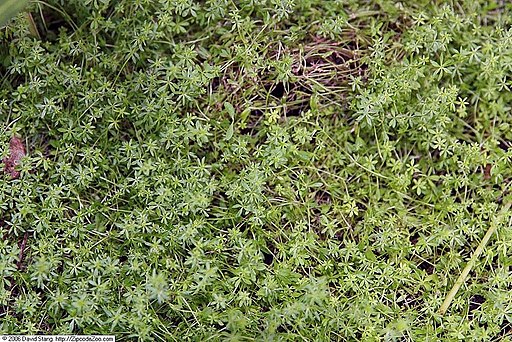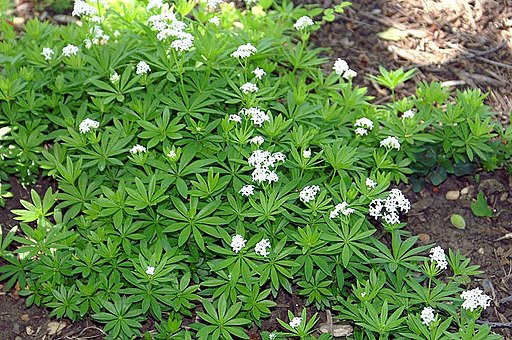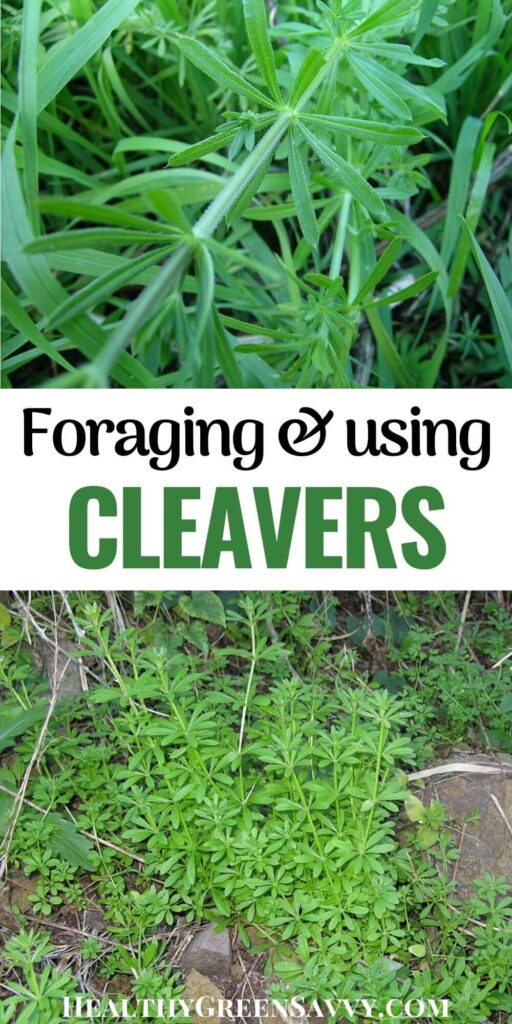Last Updated on April 23, 2024
The cleavers plant is an early spring edible with useful medicinal properties, one of many wild herbs and herbal remedies you can find in your garden. Here’s what to know about cleavers benefits and how to forage, harvest, preserve, and use cleavers herb.

GETTING TO KNOW CLEAVERS HERB
It’s always delightful to find that a new useful plant has taken up residence in my garden. We make ample use of the many edible weeds that have volunteered in our edible landscape over the years, including Virginia waterleaf, creeping Charlie, dandelions, wild violets, wood sorrel, edible clover, lambsquarters, and purslane.
Cleavers is one of the more recent arrivals, and it’s a fun one. Here’s what to know about the cleavers plant, a valuable medicinal herb and edible to welcome into your garden.
Cleavers (Galium aparine) goes by many other names, including catchweed and sticky willy, owing to cleavers’ many sticky hooks that give it its telltale feel when you touch it. Note that a small number of people have allergic reactions to cleavers, so don’t consume it if you find that your skin reacts to it.
A coffee relative, you can roast the tiny fruits of the cleavers plant to make a coffee substitute. (Dandelion root coffee is probably easier to gather material for, though.)
It’s also known as goosegrass because geese enjoy eating it, and as bedstraw because it was historically used for stuffing mattresses. Herbalist Julie Bruton-Seal notes that Lady’s Bedstraw (Galium verum) and hedgebedstraw (Galium mollugo) can be used in place of cleavers herb.

CLEAVERS HERB BENEFITS & MEDICINAL USES
Cleavers is one of the earlier plants to burst forth when the snow finally disappears and is considered a useful spring tonic after a winter of eating heavier foods. The youngest leaves may be used as a salad green early in spring, but cleavers’ tiny hairs get more pronounced as the plant ages, making the texture pretty unpalatable. Leaves may also be used as a potherb.
Herbalists recommend using cleavers to move lymph. Bruton-Seal writes, “Cleavers is a wonderfully gentle lymphatic cleanser and a fantastic spring tonic.” She notes cleavers benefits in addressing lymph-related complaints such as swollen glands, earache, and adenoid problems.
Cleavers has diuretic and anti-inflammatory properties. Cleavers is often used to treat issues involving the kidneys and urinary tract. Herbalist Devon Young notes that it may help with arthritis, gout, and prostate issues.
A cooling herb, cleavers may be used externally as a poultice to address burns, sunburns, stings, and insect bites and is often used by herbalists to help psoriasis and other skin conditions.
Early twentieth-century herbalist Maud Grieve notes cleavers’ uses as a diuretic and to address skin complaints, as well as insomnia:
Modern herbalists and homoeopaths still recognize the value of this herb, and as an alterative consider it may be given to advantage in scurvy, scrofula, psoriasis and skin diseases and eruptions generally. The expressed juice is recommended, in doses of 3 oz. twice a day, but as it is a rather powerful diuretic, care should be taken that it is not given where a tendency to diabetes is manifested. Its use, however, is recommended in dropsical complaints, as it operates with considerable power upon the urinary secretion and the urinary organs. It is given in obstructions of these organs, acting as a solvent of stone in the bladder.
A wash made from Clivers is said to be useful for sunburn and freckles, a decoction or infusion of the fresh herb being used for this purpose, applied to the face by means of a soft cloth or sponge.
Native Americans used cleavers as a diuretic, for kidney issues, and for soothing irritated skin.
Cleavers herb historically has also been used to treat cancer, and research supports its immunomodulatory properties.
CLEAVERS PLANT IDENTIFICATION
Cleavers’ name comes from one of the meanings of the verb ‘to cleave,’ or adhere to, which once you touch cleavers you’ll understand. Cleavers plants are covered with tiny hooked hairs that make them feel sticky, and if you toss a piece at yourself, you’ll find that cleavers cleave to clothing quite readily.
[You’re more likely familiar with the other use of the verb ‘to cleave,’ which oddly means the opposite, ‘to split apart,’ like a butcher’s cleaver does. If you’re a word nerd as well as a plant nerd, go look up the etymology and you’ll find these two meanings arise because they come from different, though similar-sounding roots.]
A relative of sweet woodruff, cleavers is in the same family as coffee, and cleavers seeds are sometimes roasted to make a coffee substitute.
Growth Habit
Cleavers plants have a sprawling growth habit, with square stems covered with fine hairs that grow 1 to 3 feet long. Leaves emerge from the stems in star-like patterns in groups of 6 to 8.
Leaves
Leaves are lance-shaped with pointed tips, covered with fine bristles that make them feel sticky when touched. The leaf shape of cleavers plants found in different regions varies a fair amount, as you can see in many of these images.
Flowers
Cleavers have tiny blossoms, only about 1/8″ wide, each with 4 petals.
If you’re interested in learning more about foraging and using herbs, consider taking the Herbal Academy’s online foraging course, which teaches plant identification and ethical wildcrafting practices. They also have info-packed courses on botany, wildcrafting, and herbalism. You can find a complete list here. You might also like adding some of the best herbalism books to your home library.
Cleavers Plant Look Alikes
Cleavers could be mistaken for green carpetweed (Mollugo verticillata), which is similar in appearance but doesn’t share cleavers’ sticky feel. Green carpetweed is also edible. You can read more about it here.
Cleavers plants also resemble other galliums, such as Lady’s Bedstraw (Galium verum), hedgebedstraw (Galium mollugo), fragrant bedstraw (Galium triflorum), and sweet woodruff (Galium odoratum), all of which have historical medicinal uses. Note that sweet woodruff’s coumarin content makes it an herb to consume in moderation.
The images below show how similar these plants may look, though not all are sticky like cleavers. Be sure to consult a good foraging guide to ensure correct identification. Here are my recommendations for the best foraging books.





CAUTIONS WITH CLEAVERS HERB
Some people will have skin reactions to cleavers, in which case they should NOT ingest them. Check that you don’t have a reaction before harvesting a big bunch of cleavers!
As with most herbs, no studies exist that evaluate cleavers’ safety for pregnant and breastfeeding women. According to some sources, one traditional use for cleavers was preventing pregnancy, so it’s probably best to avoid cleavers if you’re trying to conceive or are pregnant.
HARVESTING CLEAVERS PLANT & CLEAVERS HERB MEDICINAL USES
Harvest aerial parts in spring and early summer, just before flowers begin to bloom. Cut or break stems toward the bottom, but leave some flowering so your cleavers can re-seed itself for more green herbal goodness next season.
The youngest leaves of the cleavers plant can be used as a salad green before the little hooks on the leaves become more pronounced. Cleavers is most often made into a juice or tinctured fresh.
You can freeze the juice for a few months to have it on hand. You can also dry cleavers herb for tea, but it doesn’t keep long. Rico Cech cautions that its high water content can make cleavers challenging to dry. Use a drying screen to promote airflow, or use a dehydrator set to a low temperature. Once dry, store in an airtight container and try to use within a few months.
Cech suggests using a cold water infusion of cleavers herb because the medicinal components of the cleavers may be compromised by heat.
If you want to have cleavers herb after cleavers season has passed, a tincture is your best bet for something that will maintain potency longer than a few months. Here’s how to make a tincture.
For external uses, infuse cleavers into oil to use in salves.
If you don’t have access to cleavers plants, you can buy cleavers herb tinctures or dried cleavers online. Starwest sells dried cleavers herb by the pound. My favorite source for excellent prices on herbs and healthy food, Vitacost, also carries dried cleavers herb and cleavers tincture.
If you’re interested in cultivating more medicinal plants in your garden, here’s what to know about starting a medicinal herb garden.
Do you have cleavers growing in your yard? What do you like to use cleavers herb for?
Pin to save this info on cleavers plant benefits and uses for later!

Cleavers herb cover and pin photo credits: Harry Rose

Susannah is a health and environmental writer focusing on gardening, foraging, medicinal plants, and sustainability. Her work has appeared in Mother Earth Living, Ensia, Northern Gardener, Sierra, and on numerous websites. Her first book, Everything Elderberry, released in September 2020 and was a #1 new release in holistic medicine, naturopathy, herb gardening, and other categories. Find out more and grab your copy here.

 Hi, I'm Susannah, a garden geek, energy nerd, and fan of healthy food and natural remedies. Need some simple, practical solutions for living healthier and greener? You've come to the right place! More about me and my green projects
Hi, I'm Susannah, a garden geek, energy nerd, and fan of healthy food and natural remedies. Need some simple, practical solutions for living healthier and greener? You've come to the right place! More about me and my green projects